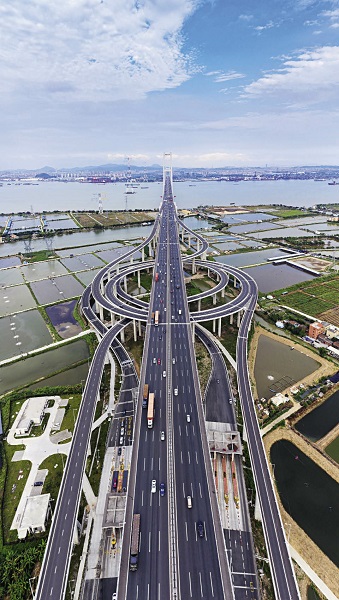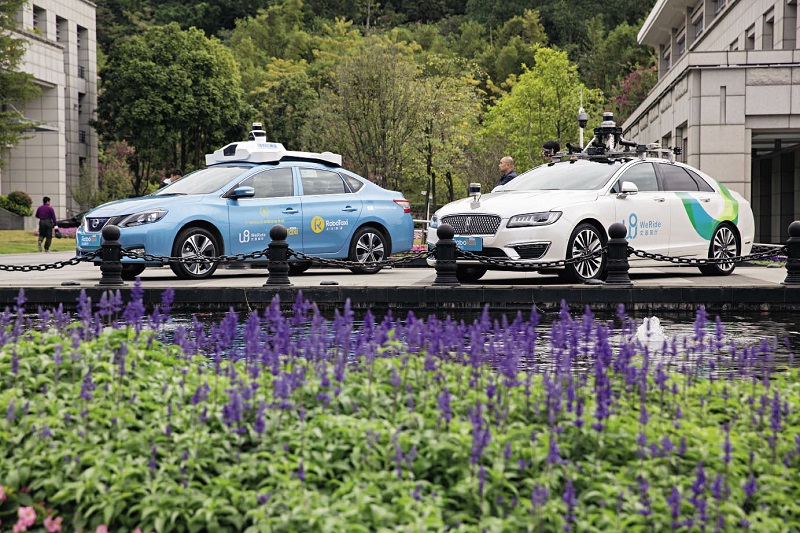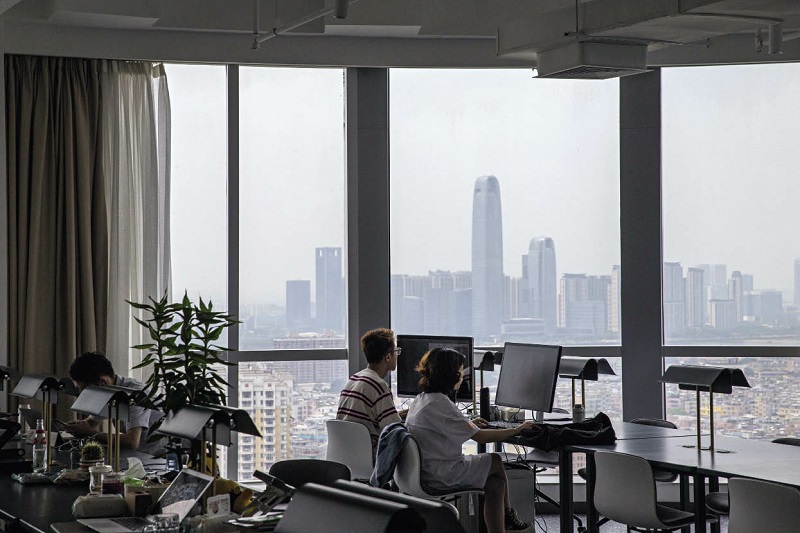
The Nansha Bridge in Guangzhou.
ON July 1, 2017, Chinese President Xi Jinping attended the signing ceremony of the framework agreement on the development of the Guangdong-Hong Kong-Macao Greater Bay Area. Since then, Guangdong Province has pooled its resources and pulled out all the stops to advance this initiative.
Connectivity and Rule Alignment
In April this year, the Nansha Bridge, which spans almost 13 kilometers and traverses the Pearl River, opened to traffic, while in September, the phase-three expansion project of Baiyun Airport in Guangzhou, the provincial capital, broke ground. With the completion of these and other infrastructure projects, travel across the Greater Bay Area is getting easier.
By the end of 2019, the mileage of express motorways in the area had reached 4,776 kilometers, and road density had risen to 8.5 kilometers per 100 square kilometers, higher than that in London, Tokyo, the Yangtze River Delta, and the Beijing-Tianjin-Hebei region. With 2,100 kilometers of rail lines in operation, an extensive high-speed railway network has taken shape. Local airports transport 223 million people and 8.15 million tons of cargo every year, among the busiest for city clusters worldwide.
It is not only the physical infrastructure that is helping with connectivity. The financial markets of Guangdong, Hong Kong, and Macao have also become more closely connected, facilitating an alignment of regulations and flow of production factors between these regions. Several reform measures in this regard, including the registration-based initial public offering system reform, establishment of Guangzhou Futures Exchange, and launch of cross-border wealth management products, have been put in place or are in the pipeline.
After the reform of the business registration system, the time needed to get a business license has been slashed to no more than three workdays, and the procedure can be completed via a single website. “It is so easy to open a business in Nanshan,” said Johnny Ma, deputy president of Macao Electronic Financial Industry Trade Promotion Association. “No administrative approval is required. All one needs to do is real-name registration, application, and a declaration letter on credibility. One can get the business license in 10 minutes.”
Mutual recognition of professional qualifications has promoted the flow of human resources from Hong Kong and Macao special administrative regions (SAR) to Pearl River Delta cities. For example, more doctors, teachers, and tour guides in the two SARs are taking the national qualification exam for their respective professions.
With their institutions and regulations better aligned, Guangdong, Hong Kong, and Macao are experiencing more coordinated development fueled by a smoother flow of personnel, goods, capital, and information.
Better Services and Environment
“Residence permits (for living in the mainland) makes travel between Hong Kong, Macao, and Guangdong easier and [help make] our life here more convenient,” said Hong, who, together with her family, were among the first to receive the permit after a new statute on its application and issuance came into effect on September 1, 2018. She said that the move signifies further integration of Hong Kong and Macao into national development.
So far Guangdong has handled 210,000 applications for residence permits, the highest number in all mainland provinces. Over recent years, Guangdong has rolled out several policies to improve services for residents of Hong Kong and Macao studying, living, working, and starting businesses in the province.
With the introduction of a favorable policy on individual income tax, the tax burden on high-caliber and sought-after professionals from overseas (including Hong Kong and Macao) has been markedly alleviated. Hong Kong and Macao residents can compete for jobs on the same terms as locals with public institutions in nine cities in the Pearl River Delta and those directly under the provincial government, and are entitled to the same remuneration and benefits package.
The review and approval process for medical aid providers in Guangdong has been optimized, and elderly care facilities, solely or jointly funded by Hong Kong and Macao investors, are treated as domestic private homes for taking care of the elderly as long as they abide by the law.
Thanks to concerted efforts by all three regions, the eco-environment has improved steadily in the Greater Bay Area. After the completion of the water resources allocation project in the Pearl River Delta, water will be diverted from the Xijiang River to the eastern part of the Delta, easing water shortages in Guangzhou, Shenzhen, and Dongguan, and replenishing water reserves in Hong Kong, Panyu, and Shunde. The air quality management program of Hong Kong, Macao and Guangdong coordinates efforts to tackle air pollution in the region, and is showing results. Last year the PM2.5 concentration in the Pearl River Delta fell to a record low, and the air quality index (AQI) reached 83.4 percent.

Two robotaxis that are part of the RoboTaxi trial operation conducted in Huangpu District and Guangzhou Development District in Guangzhou on November 28, 2019.
Paradise for Start-ups
In the Nansha area of China (Guangdong) Pilot Free Trade Zone, James Peng, co-founder and CEO of Pony.ai, is chasing after his dream. Two year ago the company developed the autonomous driving technology RoboTaxi, and tested it on urban roads in Nansha. By the end of September this year, the RoboTaxi experiment had been operating for more than 650 days during a trial run, and roamed across 200 square kilometers in Nansha.
In the field of technology, the Guangdong Pilot FTZ is now a hot destination for top-flight innovators and innovation projects from all over the world. In the Hengqin area of the FTZ, Lifanda, a biological technology company, developed a sample mRNA vaccine against COVID-19 in eight days. In the Qianhai & Shekou area, Laihua CEO Wei Bo, in his 20s, plans to build the largest 5G short video base in China.
Their ambitions are driven by the advanced infrastructure in the region. In Qianhai a composite-function information hub, a 118-meter highrise, will be completed by 2023. “The building will house more than 4,000 cabinets for core servers and digital storage devices,” said Liu Ningwu, an official with the administration of Qianhai area.
At the Nansha Port an automated pier will be built, employing new technologies like big data and AI to reduce the workers needed at a conventional pier by 60 percent. According to Chen Hongwei, deputy general manager of Guangzhou Port Co., Ltd., after its completion in 2021, the container handling capacity of Nansha Port will exceed 20 million TEUs (twenty-foot equivalent units for cargo capacity), ranking among the largest worldwide.
“The Guangdong Pilot FTZ has made remarkable achievements as a demonstration area for cooperation in the Guangdong-Hong Kong-Macao Greater Bay Area, it is becoming the forerunner in the latest round of reform and opening-up,” said Tang Wenhong, director-general of the Department of Pilot Free Trade Zones and Free Trade Ports at the Ministry of Commerce, at the news conference on the fifth anniversary of Guangdong Pilot FTZ on April 28, 2020.
During the past five years, the FTZ has worked to align mainland regulations with those of Hong Kong and Macao, and opened up the local service sector wider to investors from the two regions. Eleven law firms were established under a Guangdong-Hong Kong-Macao partnership. Meanwhile, it promotes mutual establishment of financial institutions, two-way flow of capital, and market connectivity between the three regions, lifts the investment cap in certain sectors, established a Guangdong-Macao cooperation and development fund, and has introduced a number of programs and services to facilitate exchanges among people in the three regions, such as WeChat Pay HK, Guangdong-Hong Kong joint clearing of electronic checks, cross-border payments, cross-border insurance, and cross-border housing mortgage.
To date 4,500 financial institutions from Hong Kong and Macao have set up offices in the Guangdong Pilot FTZ, making it possible for issuance of cross-border RMB loans and two-way cross-border bonds, two-way cross-border RMB cash pooling, two-way cross-border equity investment, and cross-border transfer of financial assets. As a result, cross-border financing and investment has become easier in the Great Bay Area.
The Guangdong Pilot FTZ also houses operations of most of the renowned companies in Hong Kong and Macao. Over the past several years, 16,700 additional Hong Kong and Macao-funded businesses were established in the zone. Paid-in investment from the two SARs stood at RMB 45.78 billion last year, accounting for 39.78 percent of all Hong Kong and Macao investments in Guangdong for the year 2019.

TIMETABLE is an office space in Guangzhou for cultural innovation and design startups founded by young entrepreneurs from Hong Kong and Macao.
Support for Young Entrepreneurs
“Whenever I encounter any problems and difficulties, I can seek help at the Hong Kong and Macao Youths’ Home of Tianhe District. This makes my journey of starting a business smoother,” said Mai Yuhan from Hong Kong, who founded a cross-border e-commerce business in Guangzhou in February this year. Another young entrepreneur at the Youths’ Home Huang Yongshi, from Macao, has been on the mainland for more than one year, and recently listed her company on the Shanghai Equity Exchange. “The mainland market is bigger. With help from the Youths’ Home, our projects are doing well,” she said.
Guangdong has made plans to set up innovation and start-up bases for young people from Hong Kong and Macao, providing them with subsidies and other support. At present there are nearly 50 innovation and start-up platforms and about 600 innovation teams of young people from the two SARs set up in Guangdong, whose employees exceed 4,000. As the Greater Bay Area develops, more young professionals in Hong Kong and Macao head to mainland cities for career opportunities. To help them start their careers and lives in Guangzhou, Tianhe District opened the province’s first Hong Kong and Macao Youths’ Home in 2017.
“The Youths’ Home helps us apply for apartments designated for talents needed by the city and provides consultation, training, and proxy services in multiple areas,” said Li Jianxi from Hong Kong, who now runs a live stream and short video project with his girlfriend in Guangzhou. Initially he was anxious in the new environment with very few friends around. But with the help of the Youths’ Home, he adapted quickly. His career took off, and he has now made many friends with fellow young entrepreneurs.
“We provide three-phase services – consultation, settlement, and acclimatization – to young people from Hong Kong and Macao who come here to start businesses,” said Lin Huibin, director of the Hong Kong and Macao Youths’ Home. The facility has to date served 6,000 people from the two SARs, hosted more than 250 exchange events, and assisted 70-plus companies founded by Hong Kong and Macao residents to be registered in Tianhe and start operating.
“The development prospects of the Greater Bay Area are bright, I hope I can base my life here,” said Mai Yuhan. He plans to buy a home in Guangzhou after his business picks up and bring his mother to live with him, starting a new life in the Greater Bay Area.